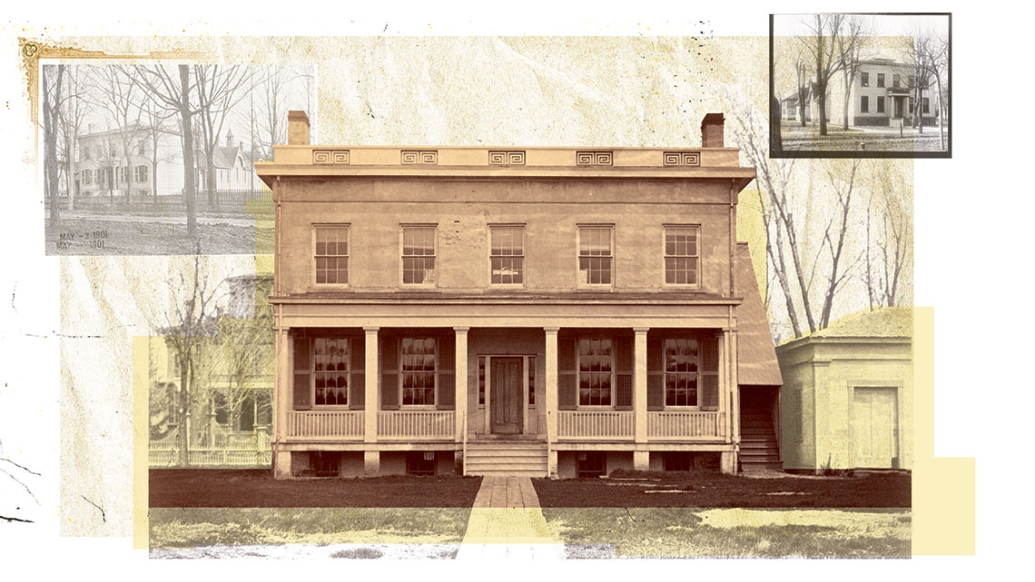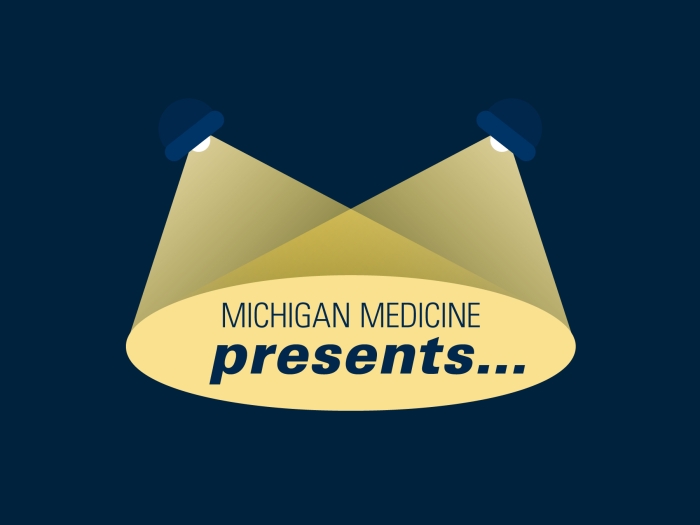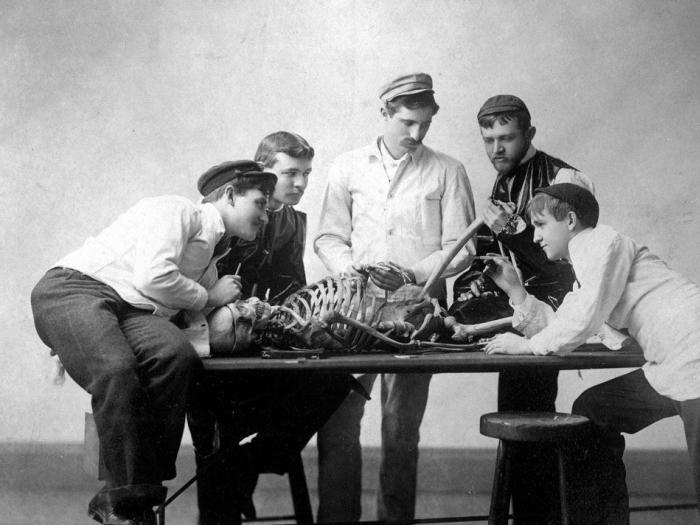150 years ago, U-M made history when it converted a professor’s house.
Author |

In the fall of 1869, U-M students saw workmen hauling furnishings out of a house on North University. One of four houses constructed 30 years earlier for faculty members, it was the one closest to the Medical Building on East University. Another was the president's house on South University, the only one of the original four that still stands today.
After the North U house's four rooms were remodeled, there were 20 tightly packed beds but no clinics, operating rooms, wards, or offices. It wasn't much. But it was the first structure in the U.S. that could rightly be called a hospital owned and operated by a university.
It was a makeshift solution to a struggle in medical education.
The First Faculty in the First Hospital
Most U.S. physicians and surgeons of the mid- 1800s had learned the trade by the same method as carpenters or blacksmiths — as apprentices who observed, then tried techniques as the master looked on. But many medical "masters" were not so masterful — incompetents and quacks were common.
In 1868 alone, some 300 volunteered to have their cases "demonstrated" in front of students. In 1869, the legislature agreed to support the conversion of an existing University building into quarters for patients — a small hospital.
At the same time, a new era in medicine was dawning. In a world without microscopes, invisible pathogens went undetected while physicians dosed their patients with traditional remedies that did little good. But by the mid-1800s, scientific investigations of disease were undermining traditional practices, and medical education was moving into the hands of physicians with training in the natural sciences.
Several such figures served as early medical faculty: Abram Sager, the first dean, a zoologist, botanist, and physician who taught the diseases of women and children; Silas H. Douglas, a professor of chemistry who came from what is now the Department of Literature, Science, and the Arts; and Zina Pitcher, a distinguished amateur botanist.
Each medical professor received a $1,000 salary. Compared to what a carpenter made in Michigan in 1850 (about $300 per year) the pay was respectable, but not what a doctor could make in a big city. So they counted on supplementing their income by treating private patients, but Ann Arbor didn't have enough people to supply them with a profitable practice. Nor was there a hospital, and that was a problem for professors who argued for more clinical training.
A Simple Mission
The leading advocate was anatomy professor Moses Gunn. He began to invite doctors from around Michigan to bring difficult cases to Ann Arbor for consultation as students watched and learned. The sessions were held two days a week. Soon Gunn was trying to shift the whole medical department to Detroit, where students could receive sustained training. Ultimately, the regents said no to a move. But the drumbeat for clinical training continued.
The Civil War put all plans for expansion on hold. Far more soldiers died from infectious diseases than from shot and shell, and the horrific casualties spurred calls for better medical training.
More and more sick people wanted to be treated by U-M's medical professors. In 1868 alone, some 300 volunteered to have their cases "demonstrated" in front of students. In 1869, the legislature agreed to support the conversion of an existing building into quarters for patients — a small hospital.
It was so small that faculty had to bring patients right into the Medical Building classrooms, performing examinations and procedures with students looking on. If patients didn't want their anatomy put on public display, they had to seek care elsewhere, and more than one was sent away when they refused to go along. The patients had to be escorted — in some cases carried — to and from the Medical Building. They couldn't stay in the classrooms, but they had to stay somewhere.
The mission of the first University Hospital was as simple as that.
Renovation and Sanitation
The Board of Regents had allocated only $637.50 for remodeling and medicines. The stucco house was so cold and smelly the first winter that the doctors had to ask for $260 more to pay for a better furnace and ventilation.
The regents remained tight-fisted, insisting the hospital pay for itself. So hospital patients were charged a few dollars a week, and U-M hired a single steward. In exchange for 75 cents a week per patient, and quarters for himself and his family, he was to "keep the fires, & wash and otherwise cleanse the rooms & make the beds as often as … proper hygiene require[s]."
The situation was a hygienic disaster. Often, a patient housed in the hospital would be taken over to the Medical Building and operated on in the same place where a cadaver had been opened up a few hours earlier. Then the patient would be hauled back over to the hospital to receive post-surgical care either from under-trained nurses or, more likely, from their family. This was unsafe for students as well. An 1873 smallpox outbreak left four students dead.
The University's Second Hospital
No one thought the North U building could serve its purpose for long. A larger structure was needed, with rooms devoted to post-operative treatment, residential wards for patients, and ventilation to mitigate unbearable stenches.
Just a few years after that building became a hospital, it was all but uncontested that clinical training was essential for medical education, but hopes for a bigger facility got tangled in a larger controversy, when state legislators demanded that the new hospital have homeopathic practitioners. The allopaths on the faculty, representing the mainstream, were bitterly opposed.
The debate went on for years. Finally, a compromise was struck. The state would help pay for a new hospital on two conditions: The citizens of Ann Arbor must agree to bear part of the cost (they did so in a landslide vote), and the hospital must have space for a new homeopathy department. Grudgingly, the regents and faculty went along.
In 1876, the doors of a new hospital opened. It was a long, low structure of two wings reaching from the professor's house into the Diag. Though it was generally called the Pavilion Hospital, its official name was University Hospital, the first facility to bear that title.
Sources include Dea H. Boster and Joel D. Howell, Medicine at Michigan: A History of the University of Michigan Medical School at the Bicentennial (2017); Reuben Peterson's unpublished history of the Medical School, held at the Bentley Historical Library; Richard M. Doolen, "The Founding of the University of Michigan Hospital: An Innovation in Medical Education," Journal of Medical Education (January 1964); Victor C. Vaughan, A Doctor's Memories (1926).





